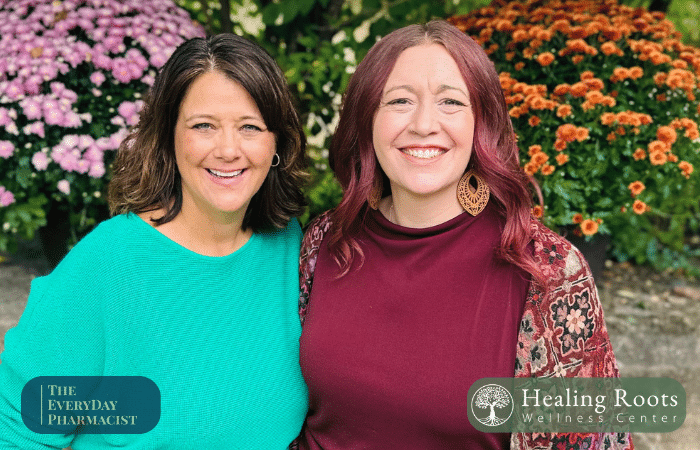
By Sarah Spangler, RPh, with contribution from Krista Day-Gloe, LCSW
As a pharmacist, I’ve always been driven by a passion to help others, but my interest in autoimmune disease treatment goes far beyond professional curiosity. My journey with childhood trauma, viral exposure, and the subsequent development of fibromyalgia has given me a unique perspective on the complex interplay between physical and emotional health.
Growing up, I experienced a childhood marked by trauma, which had a profound impact on my physical and emotional well-being. The stress and anxiety of those early years took a toll on my body, setting the stage for a lifetime of health challenges. As I navigated my teenage years and early adulthood, I began to realize the long-term effects of that trauma on my body.
In my 20s, I was exposed to viral meningitis that left me feeling exhausted and achy with daily headaches and eye pain. At the time, I didn’t realize the significance of that exposure, but looking back, I believe it was a turning point in my journey with autoimmune disease. My body’s response to that virus was abnormal, and I began to experience symptoms like unexpected weight gain and periods of extreme fatigue that would eventually become a hallmark of my fibromyalgia diagnosis.
Fast-forward to my 30s, when I started experiencing widespread pain, increased fatigue, and daily swelling of my knuckles to the point I couldn’t open my fists in the mornings. After years of searching for answers, I received a diagnosis of fibromyalgia, an autoimmune-related condition that affects millions of people worldwide. That diagnosis was both a relief and a wake-up call. I finally had a name for my symptoms, but I also realized I had to take an active role in managing my condition and making sense of it all.
As I navigated my own health journey, I began to realize the intricate connections between childhood trauma, viral exposure, and autoimmune disease. I saw how my experiences had intersected to contribute to my fibromyalgia diagnosis. This understanding sparked a passion within me to help others who are struggling with autoimmune and chronic inflammatory conditions.
Dr. Bessel van der Kolk’s book The Body Keeps the Score resonated deeply with me, as it highlights the critical role that trauma plays in shaping our physical and emotional health. I realized that my own experiences with childhood trauma had set the stage for my autoimmune disease, and I became determined to help others understand this connection.
My sister-in-law, Krista Day-Gloe, LCSW, founder of Healing Roots Wellness Center, often reminds me that we can’t think our way out of trauma. As a trauma therapist who focuses on the mind-body connection, she combines traditional therapies like EMDR with somatic and nervous-system-based approaches. Her work centers on helping the body create new, safer pathways—teaching the nervous system what safety actually feels like after years of chronic activation or shutdown.
As Krista explains:
“Our bodies are the record keepers. You can’t outthink the survival responses stored in your fascia, hormones, or gut. Real healing happens when we work with the body—through nervous system regulation, somatic awareness, and compassionate understanding of how stress physiology shows up day to day. I’ve found that traditional therapies like EMDR, CBT, or even talk therapy become far more effective once we’re working from a regulated nervous system. That’s where insight can finally take root.”
This perspective aligns with research shared in Burnout: The Secret to Unlocking the Stress Cycle by Emily and Amelia Nagoski, which emphasizes that stress isn’t just a mental state—it’s a biological process that must be completed through the body. Similarly, in The Body Keeps the Score, Dr. van der Kolk reminds us that unprocessed trauma lives in our physiology, influencing everything from immune response to emotional regulation.
By addressing both the biochemical and nervous-system aspects of healing, Healing Roots Wellness Center and The EveryDay Pharmacist are creating a collaborative model of care—one that recognizes that medications can help regulate inflammation, but the nervous system must also learn that it’s safe to rest, recover, and rebuild.
As a pharmacist, I’m committed to taking a holistic approach to autoimmune disease treatment—combining evidence-based medications to help control inflammation with complementary therapies that support nervous system regulation. By acknowledging the intersection of trauma, viruses, and autoimmune disease, we can develop more effective treatment strategies that address the root causes of these conditions. This may involve integrating therapies like approved medications, massage, mindfulness, somatic work, and EMDR—all of which can reduce stress and promote healing when guided by an informed team.
My personal journey has given me a unique perspective, as a pharmacist, on autoimmune disease treatment. I’ve experienced firsthand the complex interplay between physical and emotional health, and I’m passionate about helping others navigate this intersection. As The EveryDay Pharmacist, I’m dedicated to providing compassionate, informed care that addresses the whole person—body, mind, and spirit.
If you’re struggling with autoimmune disease, I encourage you to read The Body Keeps the Score, consider the role that trauma and viral exposure may be playing in your body, and reach out to Healing Roots Wellness Center and The EveryDay Pharmacist to help connect the dots.
At Healing Roots Wellness Center and The EveryDay Pharmacist, we both believe that healing isn’t about choosing between science and the soul—it’s about integrating them. Medications, supplements, and lifestyle interventions can help calm inflammation and balance chemistry, but if the nervous system still believes it’s in danger, the body will keep sounding the alarm.
As Krista Day-Gloe, LCSW, often shares with her clients:
“You can’t think your way out of what your body learned in survival. Healing begins when the body feels safe enough to stop defending and start repairing.”
When we approach health through this body-led lens, even traditional therapies like EMDR, CBT, and DBT become more effective—because the nervous system is finally open to new information, new pathways, and new patterns of safety.
Together, we’ve seen that when clients learn to regulate their nervous system, support their body’s biochemistry, and work through stored trauma, they begin to experience true healing—not just symptom relief. This is the heart of our shared mission: to bridge the gap between pharmacology and psychology, biology and belief, medicine and meaning.
If you’re living with an autoimmune condition or chronic stress response, we encourage you to explore these connections for yourself. Healing is not about willpower—it’s about working with your body, not against it.
For those ready to connect the dots, The EveryDay Pharmacist offers medication coaching and holistic pharmacy consultations, while Healing Roots Wellness Center provides trauma-informed therapy, nervous system regulation, and body-led mental health care. Together, we’re here to help you understand not just what’s happening in your body—but why, and how to restore balance from the inside out.
Disclaimer: At Healing Roots Wellness Center, we’re committed to supporting your mental well-being with professional care and guidance. The information shared in this blog is for educational and informational purposes only and is not intended as a substitute for personalized mental health support or medical advice, diagnosis, or treatment. While we are qualified mental health professionals, we do not diagnose medical conditions. If you have specific concerns about your health or well-being, we encourage you to seek advice from the appropriate healthcare provider. Healing Roots Wellness Center does not endorse any specific tests, products, procedures, or opinions mentioned in the blog. Reliance on the information provided is solely at your own risk. Remember, your mental health journey is unique, and the right support can make all the difference.
At Healing Roots Wellness Center, we’re committed to supporting your mental well-being with professional care and guidance. The information provided throughout our website – including blog posts, articles, and other content – is for educational and informational purposes only. It is not intended as a substitute for personalized mental health support or professional medical advice, diagnosis, or treatment. While we are qualified mental health professionals, we do not diagnose medical conditions. If you have specific concerns about your health or well-being, we encourage you to seek advice from the appropriate healthcare provider. Healing Roots Wellness Center does not endorse any specific tests, products, procedures, or opinions mentioned on our website. Reliance on the information provided is solely at your own risk. Remember, your mental health journey is unique, and the right support can make all the difference.
Whether you’re ready to schedule a free consultation or just have a few questions before getting started, you’re in the right place.
Pilar offers a compassionate, safe space to explore the impact of trauma, relationship wounds, anxiety, overwhelm, and the everyday pressures of life. If you’re longing for more authentic connection — with others and with yourself — this form is your first step.

Whether you’re seeking support for anxiety, chronic illness, trauma, parenting stress, or something else entirely — this is a safe and simple first step.
This short form will help us get to know what kind of care you’re looking for and match you with the best clinician for your needs. You can choose someone specific from our team or let us help place you with a therapist who aligns with your goals and preferences.
You’ll also have the chance to select the areas you’d like support with — whether that’s just one specialty or several.

